 Miscellaneous
Miscellaneous  Miscellaneous
Miscellaneous  Our World
Our World 10 Green Practices That Actually Make a Difference
 Humans
Humans Ten Historic Men Who Deserve Way More Credit Than They Got
 Movies and TV
Movies and TV The 10 Most Heartwarming Moments in Pixar Films
 Travel
Travel Top 10 Religious Architectural Marvels
 Creepy
Creepy 10 Haunted Places in Alabama
 History
History Top 10 Tragic Facts about England’s 9 Days Queen
 Food
Food 10 Weird Foods Inspired by Your Favorite Movies
 Religion
Religion 10 Mind-Blowing Claims and Messages Hidden in the Bible Code
 Facts
Facts 10 Things You Never Knew about the History of Gambling
 Miscellaneous
Miscellaneous Ten Groundbreaking Tattoos with Fascinating Backstories
 Our World
Our World 10 Green Practices That Actually Make a Difference
 Humans
Humans Ten Historic Men Who Deserve Way More Credit Than They Got
Who's Behind Listverse?

Jamie Frater
Head Editor
Jamie founded Listverse due to an insatiable desire to share fascinating, obscure, and bizarre facts. He has been a guest speaker on numerous national radio and television stations and is a five time published author.
More About Us Movies and TV
Movies and TV The 10 Most Heartwarming Moments in Pixar Films
 Travel
Travel Top 10 Religious Architectural Marvels
 Creepy
Creepy 10 Haunted Places in Alabama
 History
History Top 10 Tragic Facts about England’s 9 Days Queen
 Food
Food 10 Weird Foods Inspired by Your Favorite Movies
 Religion
Religion 10 Mind-Blowing Claims and Messages Hidden in the Bible Code
 Facts
Facts 10 Things You Never Knew about the History of Gambling
10 Toilet Demons And Deities From Around The World
It seems that just about any continent, city, village, or town in the world is accompanied by its own unique urban legends and superstitions, ranging from vengeful spirits to bizarre monsters to creepy ghouls. While most people look to haunted houses and graveyards to get their paranormal fix, there are numerous legends of gods, demons, and ghosts that lurk in the most private place of any building—the toilet. Yes, that’s right. Not even restrooms are safe from terrifying tales that will leave you frightened of a lot more than just running out of toilet paper.
From spirits ripping your legs off to a demon that feeds on human waste, bathrooms seem to provide anything but relief. However, if nature calls and you just can’t hold it anymore, use this list as a guide for dealing with any supernatural beings you might encounter. It may just save you from being dragged down the toilet into the pits of Hell.
10Toire No Hanako-San
In this popular Japanese tale, Toire no Hanako-san (“Hanako of the toilet”) is described as a little girl with bobbed hair and a red skirt. She inhabits the third stall on the third floor of elementary school restrooms. According to legend, children brave enough to summon Hanako should knock three times on the stall door and ask if she’s in there. While she is usually regarded as harmless—creepy, but harmless—scarier versions of the story claim that she’ll drag you into the toilet if the door is opened upon her response, unless you can present her with a perfect score on an exam.
While the legend of Hanako became a national phenomenon in the 1980s, many different origins exist of Hanako’s identity, her death, and why she haunts the bathroom. The stories range from her being killed while playing hide-and-seek during a World War II bombing raid to being strangled by an abusive adult who found her hiding in the bathroom. Toire no Hanako-san’s legend has terrified Japanese school children for almost three and a half decades. There are even variations of the legend that claim she is actually a three-meter (10 ft), three-headed lizard who uses the voice of a little girl to attract its prey; children are also warned not to fall down and scrape their knees on the playground for fear of catching the “Hanako fungus,” which causes the scab to germinate mushrooms.
9Sulak
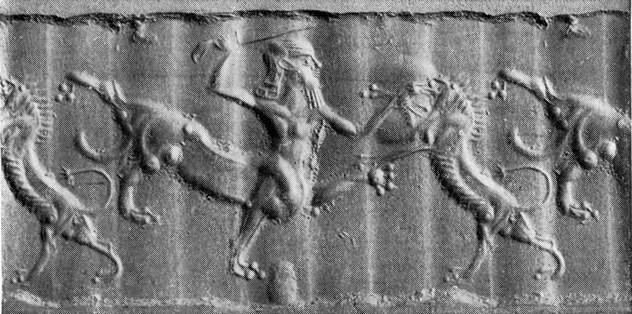
In ancient Babylonia, demons and magic were important factors in dealing with medicine and curing diseases. A probable cause of disease? The toilet. The main Babylonian medical text, the Diagnostic Handbook, written by chief scholar Esagil-kin-apli of Borsippa, describes one particular demon: Sulak. Sulak hides in places where its victims would be alone, taking the form of a lion on its hind legs. The best choice for a hiding place? Yes: the toilet. Babylonians believed that while someone was doing their business, they were at their most vulnerable state, giving Sulak the perfect opportunity to strike. Because of this belief, they referred to disease as the “hand” of Sulak. This demon was also held responsible for causing strokes and seizures if toilet users did not abide by its bathroom standards of modesty and silence.
The Jewish population in Babylon also adopted the fear of Sulak lurking in the toilets and slapping people with disease. Here he was known as the “Lurker of the Latrine” or the “Demon of the Privy.” The demon even appears in the second most important text of Judaism, the Talmud, although it is referred to as Shed Bet ha-Kise. According to the text, going to the privy alone and being respectful of Shed Bet ha-Kise by keeping quiet are key to avoiding the demon’s attack. Also, it’s important to note that upon returning from a trip to the toilet, one must walk at least half a mile away before having sex. Otherwise, the Lurker of the Latrine will ensure the children of the sinner will be epileptic.
8Kawaya No-Kami
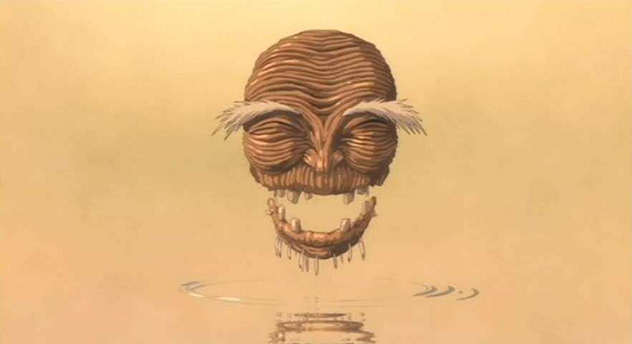
Legend claims that Kawaya no-kami, the Japanese toilet god, was born from the excrement of Izanami—the goddess of Earth and darkness. Kawaya would provide protection for people using early toilets that were darker and more dangerous than our modern facilities. People would even decorate their toilets as a shrine for Kawaya no-kami and sometimes “dine” with the god to symbolize eating food that the god had left. However, if the bathrooms didn’t stay clean or people were not respectful enough of Kawaya, their children would be born ugly and unhappy.
While protection from drowning and the assurance of a beautiful child seem like good deals, Kawaya no-kami comes with his own terrifying toilet tale. Depicted as a blind man, he was known to hide at the bottom of toilets clutching a spear. If you didn’t make your presence known by coughing before sitting down, then your trip to the bathroom could end up being anything but pleasant.
7Aka-Manto
Typically inhabiting school toilets, particularly the last stall in the women’s restroom, Aka-Manto is an evil spirit sporting a red cloak and a white mask. Creepy, right? Well, allegedly if you’re a female, you’ll find him attractive and irresistible.
This spirit is popular primarily in Japan and Korea. It is known for hiding in the stall and, upon entrance, asking whether you would prefer a red cloak or a blue cloak. If your answer is “red,” he’ll slit your throat and decapitate you so that blood runs down your back as if it were a cloak. The latter answer will get you choked until your face turns blue and you die of suffocation. So, trick him and ask for another color? Wrong. In this case, he would actually pull you into the toilet and drag you to Hell. The only way to survive an encounter with Aka-Manto is to answer “yellow,” which will result in him shoving your face into the toilet full of your own waste. Gross, but better than decapitation.
There are different origins for this creepy tale, such as reports of a red-caped vampire killing people in Tokyo, or a socialist banker wanting to cause panic during World War II. Aka-Manto didn’t settle down in the bathroom until the 1980s, where he’s been a source of haunting entertainment ever since.
6Zi-Gu

This toilet goddess, Zi-Gu, was a beautiful woman married to an actor during the Tang Dynasty in China. A high-ranking minister, Li-Jing, fell in love with Zi-Gu, so he killed her husband and took Zi-Gu captive as his mistress. While Zi-Gu was using the restroom one day, Li-Jing’s wife—who had become jealous of Zi-Gu—jumped out from behind a pile of toilet paper and murdered her. Afterward, the stall where Zi-Gu was killed became a source of haunting tales, moaning, and wailing at anyone who tried to use the facilities.
That continued until Empress Wu Zetian blessed the spirit of Zi-Gu, raising her from the demon status to Toilet Goddess. Grateful to be free of her vengeful spirit, Zi-Gu ascended to Heaven, occasionally appearing to people in the form of a beautiful woman wrapped in clouds. Generations later, she is worshiped during the Lantern Festival—the 15th night of the 1st lunar month. People hold up a puppet made of paper or wood and say “Li Jing has gone away with his official wife, let Zi Gu appear.” If properly worshiped, she will ensure that the restroom remains protected, blessed, and disinfected.
In another version, where her name is Qi Gu, she is forced to be the concubine of the Han Dynasty emperor, Liu Bang. Upon Liu Bang’s death, his wife Lu Hou demoted Qi Gu to a slave, cut off her hands and feet, sliced out her eyes, and cut her tongue, turning Qi Gu into a “human pig.” After all this, Lu threw Qi Gu into the toilet, where the hauntings began. In the end, Qi Gu was also blessed and made into the Toilet Goddess.
5Akaname
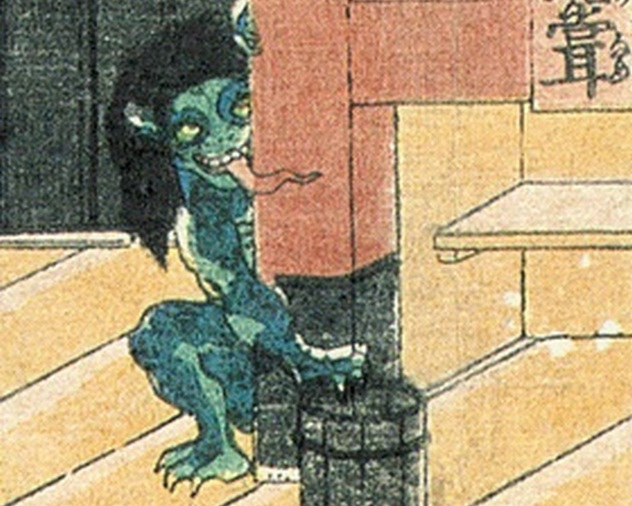
Picture a demon with a human-like body, Goblin-like face, slimy hair, one extended toenail on each foot, and an unsettling long tongue soaking in poisonous saliva. Just from his appearance, he may seem like the last thing you would ever want to encounter, but this Japanese bathroom spirit is far less harmful than he looks. Born out of scum and attracted to untidiness, Akaname’s purpose is to lick up filth and grime plaguing restrooms in hard-to-reach places. Akaname is thought to have originated as a scare tactic to motivate children to keep their bathrooms clean.
However, with the exception of potentially spreading disease, Akaname is completely harmless and doesn’t even have the intention of scaring you. He just wants a clean toilet, making him the most helpful and useful bathroom spirit on this list. Just stay out of the way of his poisonous tongue, and you’ll never have to lift a finger to clean the restroom again. That is, if you can stand his terrifying appearance.
4Belphegor
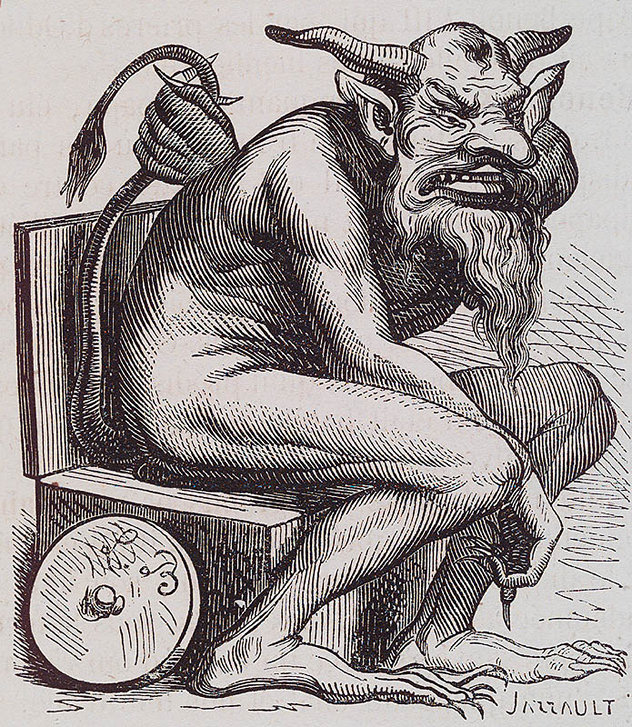
Belphegor—the Judeo-Christian demon of discoveries, inventions, and laziness—usually appears as a beautiful girl and offers wealth in hopes of driving her victims toward greed and selfishness. Unluckier people will see Belphegor’s true appearance: a bearded, horned demon with a perpetually opened mouth and sharp nails, who sits on a toilet throne. That, or a phallus. Belphegor was worshiped by the Moabites on Mount Phegor in the Middle East. Rabbis claimed Belphegor could only be invoked by sitting on the toilet and doing your business.
Another way he could have been worshiped was by displaying all bodily orifices, turning around, relieving yourself, and offering your excrement to the demon as sacrifice. Basically, he’s a lazy demon who sits on a toilet all day, eating human waste he finds to be a delicacy. So the next time nature calls, remember that anything going in the toilet may be Belphegor’s next meal. There’s a chance you’ll be rewarded with success and wealth in return.
3Kashima Reiko
Legend has it that Kashima Reiko was attacked by a group of men, beaten to a pulp, and left for dead. Searching for help, she crawled onto a railway track before falling unconscious, only to be killed and severed at the waist by an oncoming train. Because of her agonizing end, she returned from the dead as an Onryo—a vengeful spirit commonly found in Japanese folklore. Searching for her legs, she prefers to hide in school restrooms, yet she is also known to make appearances in household bathrooms.
The legend also claims that Kashima Reiko visits you within a month of you hearing her tragic tale. To avoid having your own legs torn off, you should answer “On the Meishin Expressway” if Kashima Reiko asks where her legs are. “Who told you that?” she will ask then. The correct response would be “Kashima Reiko told me.” But if she ever asks what her name is, it’s a trick question. Translate her name to “Mask Death Demon,” and she’ll leave you be.
2Cloacina, Stercutius, And Crepitus
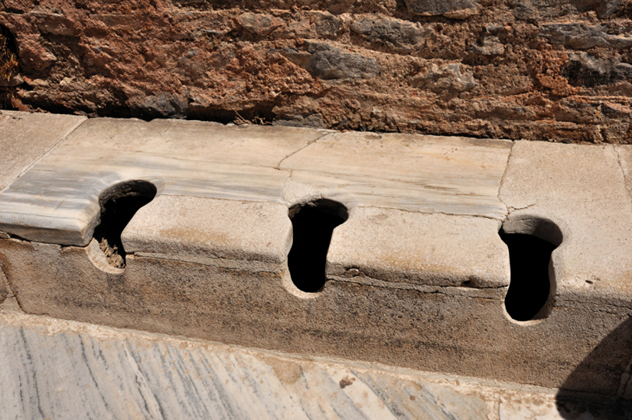
With Cloacina, the sewer goddess, and Stercutius, the god of dung, ancient Rome was no stranger to worshiping deities that were related to the restroom. However, the Roman’s primary toilet god was known as Crepitus, who not only ruled over the latrine, but was also the god of flatulence. Yes, the ancient Romans had a god for farts.
According to mythology, Crepitus was summoned when one was constipated or had diarrhea. Thus, despite his helpfulness, he probably wasn’t the type of deity you’d like to encounter often. Cloacina, on the other hand, was a useful goddess, summoned when the sewers were backed up or blocked. In the eighth century B.C., the Sabine king Titus Tatius even erected a shrine in honor of Cloacina, revealing Rome’s dependency on her in keeping the sewer system running effectively. Even Stercutius was an important divine figure in Rome at the time. Because of his godly ruling of all things dung and excrement, he was connected to agriculture—manure was a necessary factor in keeping crops lush and fertile.
But why so many toilet deities? Romans were actually very afraid of toilets, convinced that demons and devils lurked in the sewer system. They believed a person was most exposed while sitting on the toilet, leaving them vulnerable to the evils below. In order to counteract this, the Romans were faithful to their toilet deities. They hoped the gods would keep the sewer unblocked, clear up any unfortunate bodily functions, help the growth of crops, and protect people from any foul or vile spirits waiting to attack.
1Jinn
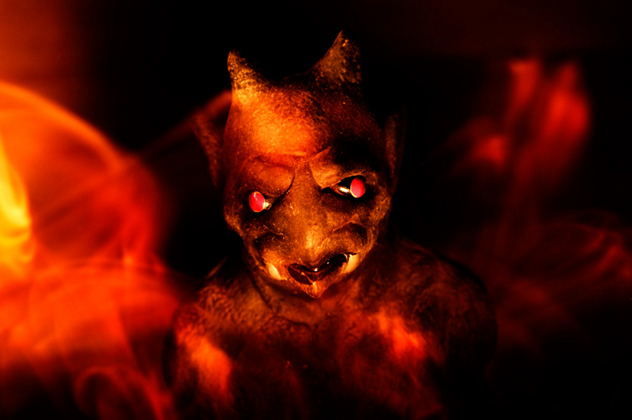
The jinn, or genies, are Islamic supernatural creatures that are described as being on fire, yet smokeless. The jinn are able to physically interact with people and objects as they choose. According to the Quran, the jinn can see you, but you cannot see them. Because of their evil disposition, the jinn like to inhabit dirty toilets.
So what happens if you encounter one of these demons while trying to go to the bathroom? If the jinn in your toilet sounds like Robin Williams, then consider yourself lucky; other jinn have been known to possess their victims and cause permanent insanity. For this reason, jinn have always been, and still are, feared by people of the Islamic faith. Prophet Muhammad taught that to protect oneself from a jinn, one must seek refuge in Allah, reciting certain chapters of the Quran and mentioning the name of Allah before taking one’s clothes off and sitting on the toilet. This will prevent the jinn from seeing one’s private parts, by placing an invisible veil between you and the jinn.








